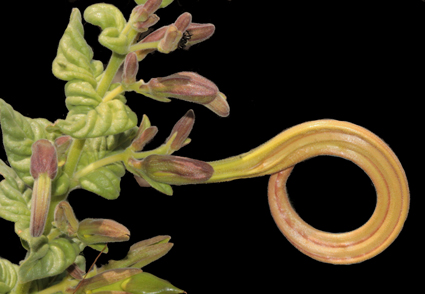Abstract
During floral biology studies in Northeastern Brazil, populations of Harpochilus from central-southern Bahia have been found to differ from H. neesianus. Following extensive fieldwork and floral visitor observations, studies of all available specimens, coupled with micromorphology of indumentum and pollen, we have gathered sufficient evidence to recognize these populations as distinct and a new species. H. corrugatus is hereby described and illustrated. Harpochilus corrugatus differs from its closest ally, H. neesianus, by having sessile, corrugate, deltoid leaves and yellow flowers with a brownish-purple hue. A distribution map and identification key to distinguish the three species of the genus are presented, and the IUCN category of threat for the new species was assessed as Endangered. Glossophaginae bats were observed to be the floral visitor, suggesting that this is another bat-pollinated species of that genus from the Caatinga biome.
References
Bentham, G. (1876) Acanthaceae. In: Bentham, G. & Hooker, J.D. (Eds.) Genera plantarum 2 (2). Reeve & Co. and Williams & Norgate, Londini [London], pp. 1060–1122.
Côrtes, A.L.A., Borges, R.L.B. & Rapini, A. (2010) Reinstatement of Thyrsacanthus Moric. (Acanthaceae) and taxonomic novelties in the genus. Taxon 59: 965–972. https://doi.org/10.1002/tax.593025
Côrtes, A.L.A. & Rapini, A. (2013) Justicieae (Acanthaceae) do Semiárido do Estado da Bahia, Brasil. Hoehnea 40: 253–292. https://doi.org/10.1590/S2236-89062013000200003
Costa-Lima, J.L.D. & Chagas, E.C.D.O. (2019) A revision of Harpochilus sheds light on new combinations under Justicia (Acanthaceae). Phytotaxa 393: 119–130. https://doi.org/10.11646/phytotaxa.393.2.3
Diniz, U.M., Domingos-Melo, A. & Machado, I.C. (2019) Flowers up! The effect of floral height along the shoot axis on the fitness of bat-pollinated species. Annals of Botany 124: 809–818. https://doi.org/10.1093/aob/mcz116
Dobat, K. & Peikert-Holle, T. (1985) Blüten und Fledermäuse. Waldemar Kramer, Frankfurt.
Dumortier, B.C.J. (1829) Analyse des familles des plantes, avec l’indication des principaux genres qui s’y rattachent. J. Casterman, Ainé, Tournay, 104 pp. https://doi.org/10.5962/bhl.title.443
Fleming, T.H., Geiselman, C. & Kress, W.J. (2009) The evolution of bat pollination: a phylogenetic perspective. Annals of Botany 104: 1017–1043. https://doi.org/10.1093/aob/mcp197
INCT (2021) Herbário Virtual da Flora e dos Fungos. Available from: https://specieslink.net/ (accessed 1 January 2022)
IUCN (2014) IUCN Red List Categories and Criteria: Version 3.1. Second edition. Gland, Switzerland and Cambridge, UK: IUCN. 2nd ed. IUCN, Gland, Switzerland & Cambridge, UK. pp. 1–32.
Kiel, C.A., Daniel, T.F., Darbyshire, I. & McDade, L.A. (2017) Unraveling relationships in the morphologically diverse and taxonomically challenging “justicioid” lineage (Acanthaceae: Justicieae). Taxon 66: 645–674. https://doi.org/10.12705/663.8
Kiel, C.A., Daniel, T.F. & McDade, L.A. (2018) Phylogenetics of New World “justicioids” (Justicieae: Acanthaceae): Major Lineages, Morphological Patterns, and Widespread Incongruence with Classification. Systematic Botany 43: 459–484. https://doi.org/10.1600/036364418X697201
Lindau, G.B. (1895) Acanthaceae. In: Engler, A. & Prantl, K. (Eds.) Die Natürlichen Pflanzenfamilien nebst ihren Gattungen und wichtigeren Arten, insbesondere den Nutzpflanzen, unter Mitwirkung zahlreicher hervorragender Fachgelehrten begründet, IV Teil, 3 Abteilun b. Verlag von Wilhelm Engelmann, Leipzig, pp. 274–354.
Lindau, G. (1914) Acanthaceae. In: Pilger, R. (1914) Plantae Uleanae novae vel minus cognitae. Notizblatt des Königlichen Botanischen Gartens und Museums zu Berlin 6: 192–200. https://doi.org/10.2307/3994404
Linnaeus, C. (1753) Species Plantarum 1. Impensis Laurentii Salvii, Stockholm, 560 pp. https://doi.org/10.5962/bhl.title.669
Martius, C.F.P. (1829) Nova genera et species plantarum: quas in itinere per Brasiliam MDCCCXVII-MDCCCXX jussu et auspiciis Maximiliani Josephi I., Bavariae regis augustissimi instituto, vol. III. Caroli Wolf, Monachii [Munich], 198 pp.
McDade, L.A., Daniel, T.F. & Kiel, C.A. (2018) The Tetramerium Lineage (Acanthaceae, Justicieae) Revisited: Phylogenetic Relationships Reveal Polyphyly of Many New World Genera Accompanied by Rampant Evolution of Floral Morphology. Systematic Botany 43: 97–116. https://doi.org/10.1600/036364418X697003
Monteiro, F.K.S., Fernando, E.M.P., Lucena, M.F.A. & Melo, J.I.M. (2018) A new species of northeastern Brazilian endemic genus Harpochilus (Acanthaceae). Phytotaxa 358: 289–294. https://doi.org/10.11646/phytotaxa.358.3.6
Moricand, S. (1847) Plantes nouvelles d’Amerique 9. Jules G. Fick, Genève, pp. 141–176.
Nees von Esenbeck, C.G. (1832) Acanthaceae Indiae Orientalis. In: Wallich, N. (Ed.) Plantae Asiaticae rariores 3. Treuttel and Würtz, London, pp. 70–117. https://doi.org/10.5962/bhl.title.468
Nees von Esenbeck, C.G. (1847) Acanthaceae. In: von Martius, K.P., Eichler, A.G. & Urban, I. (Eds.) Flora Brasiliensis 9. Typographia Regia, Monachii, pp. 1–164, t. 1–31.
Profice, S. & Leitman, P. (2013) Clistax bahiensis (Acanthaceae), a new epiphytic species from Bahia, Brazil. Phytotaxa 132 (1): 48–51. https://doi.org/10.11646/phytotaxa.132.1.4
Radford, E., Dickison, W.C., Massey, J.R. & Bell, C.R. (1974) Vascular plant systematics. 2nd ed. Harper and Row, New York. 891 pp.
REFLORA 2020 (2021) Reflora - Virtual Herbarium. Available from: http://reflora.jbrj.gov.br/reflora/herbarioVirtual/ (accessed 1 November 2021)
Rizzini, C.T. (1948) Disquisito Circa Acanthacearum Aliquot Genera Brasiliensia. Archivos do Jardim Botanico do Rio de Janeiro 8: 295–372.
Robards, A.W. (1978) An introduction to techniques for scanning electron microscopy of plant cells. Electron Microscopy and Cytochemistry of Plant Cells, ed. J. L. Hall. Elsevier, New York, pp. 343–403.
Silva, R.M. & Consolaro, H.N. (2015) Polinização e sistema reprodutivo de Acanthaceae Juss. no Brasil: uma revisão. Bioscience Journal 31: 890–907. https://doi.org/10.14393/BJ-v31n3a2015-23979
Thiers, B. (2020 [continuously updated]) Index Herbariorum: a global directory of public herbaria and associated staff. Available from: http://sweetgum.nybg.org/science/ih/ (accessed 1 January 2020)
Vogel, S. (1969) Chiropterophilie in der neotropischen Flora Neue Mitteilungen II. Flora oder Allgemeine botanische Zeitung. Abt. B, Morphologie und Geobotanik 158: 185–222. https://doi.org/10.1016/S0367-1801(17)30208-9
Vogel, S., Machado, I.C. & Lopes, A.V. (2004) Harpochilus neesianus and other novel cases of chiropterophily in neotropical Acanthaceae. Taxon 53: 55–60. https://doi.org/10.2307/4135488
Wasshausen, D.C. (1973) New combinations in cultivated Justicia (Acanthaceae). Baileya 19 (1): 1–3.


